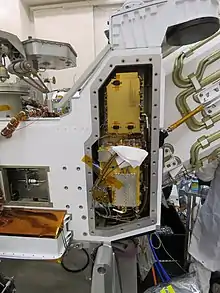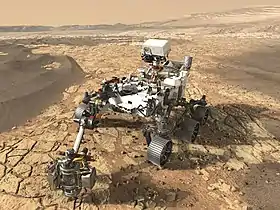RIMFAX
The Radar Imager for Mars' subsurface experiment (RIMFAX) is a ground-penetrating radar on the planned Perseverance rover, part of the Mars 2020 mission. It uses radar waves to see geologic features under the surface.
 RIMFAX | |
| Operator | NASA |
|---|---|
| Manufacturer | Norwegian Defence Research Establishment |
| Instrument type | Ground-penetrating radar |
| Function | Study subsurface structure |
| Properties | |
| Mass | 3 kg (6.6 lb) |
| Dimensions | 19.6 × 12.0 × 0.66 cm |
| Power consumption | Max: 10 watts |
| Resolution | 15 cm to 30 cm (3" to 12") |
| Host spacecraft | |
| Spacecraft | Perseverance |
| Launch date | July 2020 (planned) |
| Rocket | Atlas V 541 |
| Launch site | Cape Canaveral SLC-41 |
The device can make detections perhaps dozens of meters/yards underneath ground, such as for buried sand dunes or lava feature.[1] During development a detection range of about 10 yards/meters was targeted, and tests on glaciers were successful.[2]
RIMFAX takes its name from Hrímfaxi, the horse in Norse mythology that "faithfully brings the night."[3]
The radar will operate at radio frequencies of 150–1200 MHz and will use a Bow-Tie Slot antenna.[4]
Overview
RIMFAX is a ground-penetrating radar, its antenna is located on the lower rear of the Perseverance rover. It will be able to image different ground densities, structural layers, buried rocks, meteorites, and detect underground water ice and salty brine at 10 metres (33 ft) depth.
Ground-penetrating radars (GPR) send radio frequency electromagnetic waves into the ground and then detect the reflected signals as a function of time to reveal subsurface structure as well as composition. RIMFAX is based on a number of GPR instruments developed at the Norwegian Defence Research Establishment (FFI).[5] RIMFAX was selected by NASA to be one of the instruments on the Mars 2020 rover in July 2014. RIMFAX will provide the science team with the capability to assess the shallow layers and their stratigraphic relationship to nearby outcrops, and thus a window into the geological history and associated environmental history.[5]
The RIMFAX instrument is being developed and build by FFI and it will be delivered to NASA's Jet Propulsion Laboratory for integration with the rover in December 2018. The RIMFAX operations center will be located at the University of California, Los Angeles (UCLA), and the RIMFAX data will be archived by NASA's Planetary Data System. The RIMFAX Principal Investigator is Svein-Erik Hamran of FFI, and his team includes scientists from Norway, Canada and the United States.[6]
Specifications
RIMFAX employs a Gated Frequency Modulated Continuous Wave (FMCW) waveform to probe the subsurface. RIMFAX will be commanded to acquire radar soundings every 10–20 cm along the rover's path to create two-dimensional GPR images of subsurface structure.

| Specifications | Units/performance[3][5] |
|---|---|
| Mass | 3 kg (6.6 lb) |
| Power | 5 to 10 watts |
| Dimensions | 19.6 × 12.0 × 0.66 cm (7.0" × 4.7" × 2.4") |
| Data return | 5 to 10 kbytes per sounding location |
| Frequency range | 150 to 1200 MHz |
| Vertical resolution | 15 cm to 30 cm (3" to 12") |
| Penetration depth | ≤10 m (33 ft) |
| Measurement interval | Every 10 cm (3.9 in) |
Contemporaries
Other Mars radar experiments include SHARAD, MARSIS, and WISDOM.[7]
See also
References
- "Next Mars rover will use 'X-ray vision' to spot buried treasure". CBC News. Retrieved 2018-01-24.
- Hamran, S. E.; Berger, T.; Brovoll, S.; Damsgård, L.; Helleren, Ø; Øyan, M. J.; Amundsen, H. E.; Carter, L.; Ghent, R. (July 2015). "RIMFAX: A GPR for the Mars 2020 rover mission". 2015 8th International Workshop on Advanced Ground Penetrating Radar (IWAGPR): 1–4. doi:10.1109/IWAGPR.2015.7292690. ISBN 978-1-4799-6495-6.
- "Mars 2020 Rover - RIMFAX". NASA. 2017. Retrieved 2017-10-22.
- "RIMFAX: A GPR for the Mars 2020 rover mission - IEEE Conference Publication". doi:10.1109/IWAGPR.2015.7292690. Cite journal requires
|journal=(help) - "RIMFAX - ground penetrating radar". Norwegian Defence Research Establishment. 2015-08-14. Retrieved 2020-12-17.
- RIMFAX: Science team. Norwegian Defence Research Establishment (FFI), 2017.
